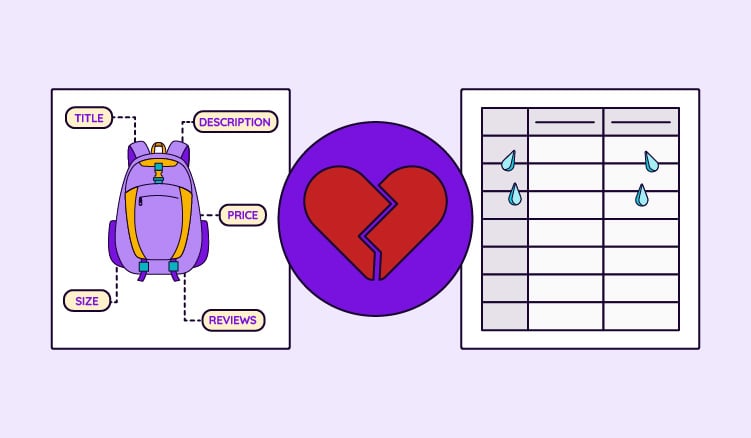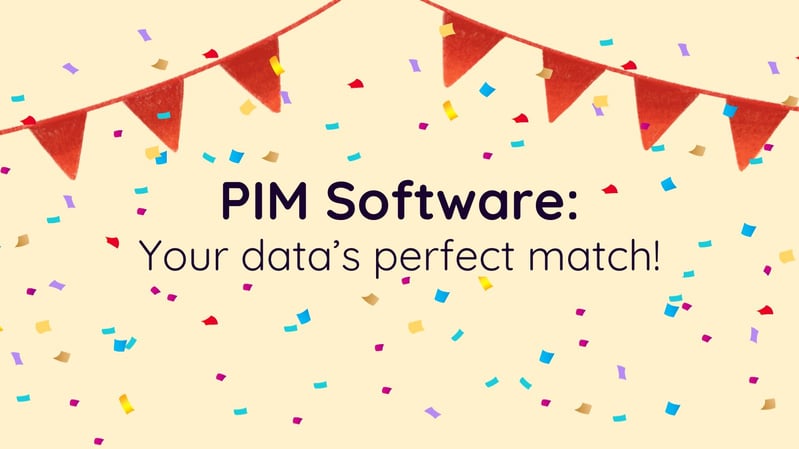
Keep the good stuff coming
Subscribe to our blog newsletter and get monthly content that helps you manage product data smarter.
No spam. Just real value.
Any experienced retailer knows that you have to prepare for seasonal events well in advance, so it should come as no surprise that we’re already thinking about Valentine’s Day, hopeless romantics that we are. Don’t go breaking out the heart-shaped candies and overpriced roses just yet though! While some relationships are built to last, in this article we’re going to be looking at one that might not be: Your product information and spreadsheets.
Don’t get me wrong, I’m sure at the start it felt like love at first sight, with those spreadsheets effortlessly fulfilling all of your data needs and desires. But just like in life, needs can change as we (and our companies) grow and evolve, making it time to reevaluate if the tool we’re so fond of is still the best fit.
So on that note, here are 7 red flags to look out for that may indicate that your product data + spreadsheets may not be “4eva.”
Red Flag #1: Feeling stuck in a rut (a.k.a. distribution issues)
In life, it’s far too easy to fall into a pattern of just doing the same thing again and again, especially if your partner has no inclination to push the boundaries. Sticking with the same old spreadsheet system might be what’s holding your ecommerce business back and stopping it from reaching its full potential, especially given spreadsheets’ lack of advanced features for things like distributing your data to your different systems and storefronts.
It’s like wanting to travel the world with your partner, but them never wanting to leave your hometown. Sure, you’re ready to start selling on new marketplaces and expanding your retail horizons, but if your spreadsheets don’t have the necessary technical capabilities then they’re only going to stand in your way. You’re better off looking for software with features and functions to support your journey, like product data feeds that let you send your information to marketplaces automatically on a schedule of your choosing.
Red Flag #2: Communication breakdown (a.k.a. data inconsistency)
Misunderstandings and lack of communication have led to the disintegration of many, many relationships of many different forms. Similarly, when multiple teams use spreadsheets, information can get lost, duplicated, or become outdated, leading to costly mistakes and inefficiencies—talk about trouble in paradise.
Think of it as those times you thought you and your partner had plans on Friday, but they thought it was Saturday. Now, translate that to your finance team updating prices on one spreadsheet, while sales are still looking at an older version. The result? Misinformed customers and potential lost sales. Gosh, if only there was a way to get everybody on the same page, communicating openly about what’s really going on with them…

Know what made this group high-five possible? Communication! (Source)
Red Flag #3: Too high maintenance (a.k.a. manual updates)
It’s sad, but it’s true: Some relationships are just too much work to keep going. If your team is spending countless hours maintaining, updating, and fixing errors in spreadsheets, that’s a sign that your current system’s becoming too high-maintenance.
Imagine having a partner who needs you to recount every minute detail of your day, every day, the second you get home, and who is also incapable of doing anything for themselves. If every product update or addition requires manual entry, adjustments, and cross-checks across multiple spreadsheets, and it’s then up to you to distribute the updated data to all your different sales channels and platforms yourself, well, maybe it’s a sign you’d be better off with a more helpful partner.
Red Flag #4: You can’t rely on them (a.k.a. data silos)
A cornerstone of any successful relationship is trust, and feeling like you can depend on your other half to be there when you need them. If your vital information is in a bunch of different spreadsheets in a bunch of different places with a bunch of different formats, update schedules, and so on, then maybe your current system isn’t all that.
Think of it like that one slightly scatterbrained friend we all have who somehow manages to lose their phone three times a week, or spends the day looking for the glasses on top of their head. Keeping your product information in a bunch of scattered spreadsheets is like giving that friend your spare keys to look after, or asking them to feed your pets while you’re away—not the best idea. When it comes to the stuff that’s important to you, you want to know everything’s going to be in a safe place and easily retrievable anytime you ask—that’s why switching to a centralized data storage system is going to give you a lot less stress down the road.

He’s looking at your spreadsheets, FYI. (Source)
Red Flag #5: They don’t support your artistic side (a.k.a. no DAM functionality)
Just like how in some relationships, one partner might feel they can't fully express themselves if they’re not supported, using only spreadsheets might leave you feeling boxed in. Today's dynamic ecommerce landscape necessitates rich media content everywhere that you sell—after all, 75% of people shopping online depend on product photos when they’re deciding whether or not to buy something.
Spreadsheets are like a partner that tells you those painting classes are a waste of time, or to stop making so much noise with that guitar. They just can’t process media, whether it’s images, videos, audios, or anything else that will give your product listings some razzle dazzle. You’re confined to cells and tabs that can only handle certain types of data, which stifles your creative potential when presenting your products. Using software with DAM functionality, on the other hand, lets you express your artistic flair to your heart’s content, as it helps keep your creations in mint condition and then proudly display them far and wide.
Red Flag #6: Not making an effort with your friends (a.k.a. lack of integrations)
In any strong relationship, making an effort to integrate and be compatible with each other's friends and support systems is a must. The same goes for your product data and technology—whatever you use to store your product information should be able to seamlessly work with the other technological tools and platforms you use.
Imagine planning a dinner party, and your partner refuses to converse with some of your closest friends, or worse yet, disrupts the flow of the evening by creating friction with the other guests. That’s the spreadsheet that doesn’t integrate well with your CRM, your ecommerce platform, or your marketing automation tools. Suddenly, data transfer is a hassle, leading to errors, miscommunication, and you having to constantly play mediator between your data tool and the other platforms you depend on. If your spreadsheets aren’t making an effort to be compatible with your other systems, maybe it's time to think about a solution that would.

Hilarious? Sure. What you want to happen at your dinner party? Not so much. (Source)
Red Flag #7: Meeting someone who’s a better match (a.k.a. finding better software)
Sometimes, finding something new that’s a better fit can lead a person to reconsider their current situation. In the business world, that 'something new' might be the advanced capabilities offered by Product Information Management (PIM) systems, Master Data Management (MDM) software, or a Feed Management tool.
It’s like seeing your friends in fulfilling relationships while you’re stuck in a stagnant one, and in the world of product management, there are plenty of fulfilling relationships out there. Finding the right tech solution for you and your business promises a lifetime of happiness, in the form of increased efficiency, integration capabilities, and smoother workflows, just like in all those fairytales we read as kids. When you see competitors leveraging these advantages and getting their happily-ever-after, it’s hard not to start wondering if your current choice is really the most charming option.
So there you have it: Enough red flags to make the beautiful bunting down below. Hopefully, these examples can serve as a guide when evaluating the relationship you have with your spreadsheets. Sometimes, recognizing the signs is the first step toward making a change for the better.
Switching from spreadsheets to dedicated PIM software is like moving on from a fling to a committed, long-term relationship. The transition might feel daunting, but the benefits—streamlined operations, accurate data, and enhanced collaboration—are well worth the leap. After all, it's not just about parting ways with something familiar but about embracing opportunities that allow for growth, efficiency, and success.
It's time to have 'the talk' with your spreadsheets. Are you ready to move on to something better?
Frequently Asked Questions
Product data is all the info about a product—from specs and images to price and how much stock is left.
While spreadsheets can get the job done, as data grows, they can become a bit hard to manage. Specialized tools are more efficient for larger operations.
Aside from potential data inaccuracies, there's a concern about security, collaboration challenges, and the overall time spent managing and analyzing data.
Spreadsheets can struggle with large datasets—real-time collaboration is tricky, and the potential for manual errors increases.
Absolutely. If you're in sectors like ecommerce, retail, or manufacturing (or you're juggling loads of product data), a more robust solution might be in order.

What if your product data actually worked for you?
We’ll show you how Plytix helps you stop fixing data—and start using it.
Related posts
Keep the good stuff coming
Subscribe to our blog newsletter and get monthly content that helps you manage product data smarter.
No spam. Just real value.








Think others should see this?
Go ahead and share it.